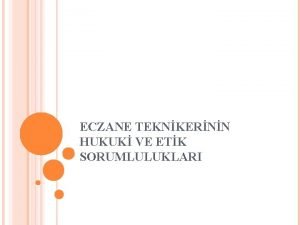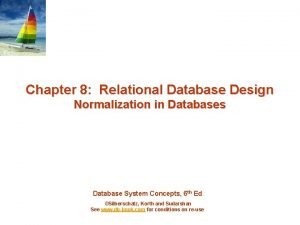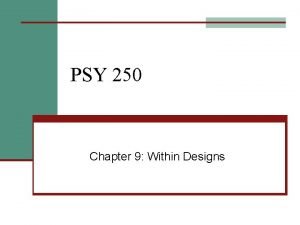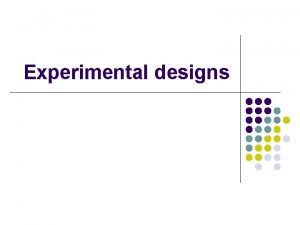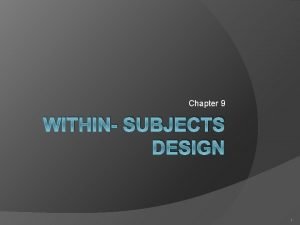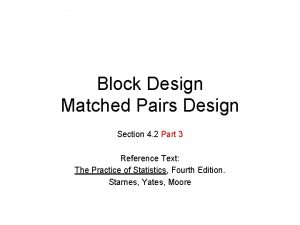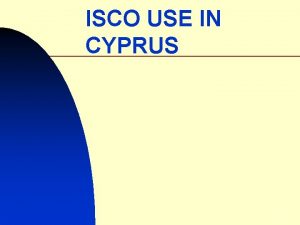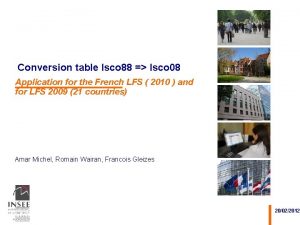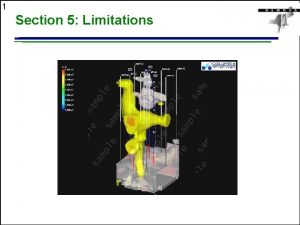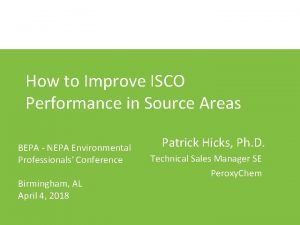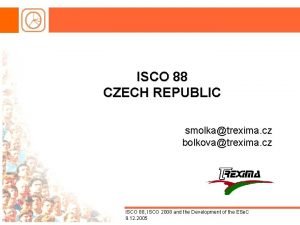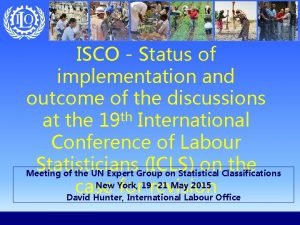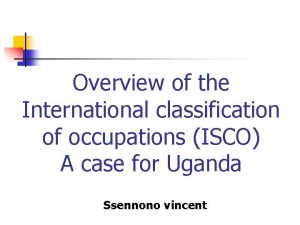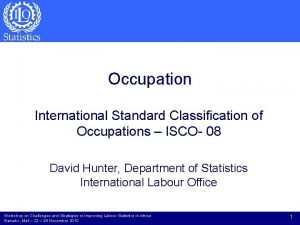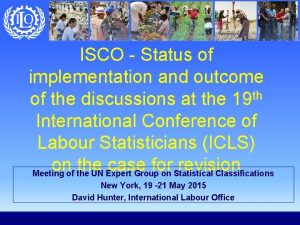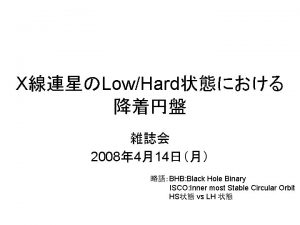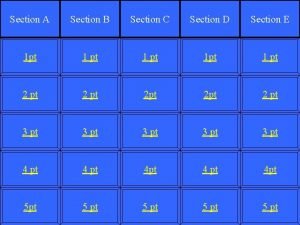1 Section 6 ISCO DESIGN u u u

















- Slides: 17

1 Section 6 - ISCO DESIGN u u u u Initial Site Evaluation ISCO Compatibility ISCO Modeling and Dosage Considerations Bench Testing Pilot Testing/Delivery System Evaluation Full Scale Combination Technologies

2 ISCO Design Process • Initial Technology Screening • Modeling • Design Parameter Evaluation and Bench Testing • Field Pilot/Initial Application • Full Scale Application

3 Example Laboratory Test • Oxidation Estimating Tool (OET) is predictive empirical model to estimate overall oxidant demand (OD) • Stochiometry is only a small fraction of the actual oxidant required for ISCO • Treatability test is run on several formulations to develop an efficiency curve and confirm OD • The primary purposes of the OET are: 1. To determine the reactivity of the site media 2. To select the optimum reagent formulation 3. To observe adverse reactions, if any

4 OET Model • Site Geochemistry/Geology Well Contaminants-Total Mass Treatment Volume Estimate

5 Site Geochemistry/Geology Range Limits Units Value % 0. 3 Permeability md 3574. 237 1 - 10, 000 p. H s. u. 6. 5 <8. 5 u. S/cm 500 100 - 6000 0 F 65 32 - 130 0. 02 0. 0001 0. 2 • Porosity Specific conductance Groundwater temperature Groundwater velocity ft/day Notes

6 Site Geochemistry/Geology Units Value Range Limits m. V 0 70 - (-70) Grain size mm 0. 07 Dissolved oxygen (DO) ppm 4 0. 01 - 25 TDS ppm 500 50 - 1500 TOC in groundwater ppm 4 <40 Hydroxyl scavenger ppm 100 <400 • Redox potential (ORP) Well diameter inch 11/2 Notes 10% pt. new SS

Contaminant Mass PSH, Sorbed, Dissolved 7 Clean. OX Appl. Well • Number of Wells Existing MW Total VOCs (average for all Areas) Area 1 850 100 x 75 ppm TIC ppm TPH/Cosolvents ppm 0 0 10 Area 2 - 300 x 130 (includes Area 1) 35 Area 3 - 185 x 125 20 Multiply the number of wells times the reagent requirement Total Contaminant Load ppm 850

8 Treatment Volume Estimate Clean. OX Appl. Well Existing MW • Radius of Influence ft 20 Area of Influence sft 1258 Screen Depth, top ft 5 Screen Depth, bot. ft 30 Total Treatment Volume cft 31450 Total Groundwater Volume gal 70583 Total Groundwater Weight lb 588744

9 Design of Delivery Systems u Sufficient number of wells to provide adequate overlap of “effective zones” • Can use trenches u u Usually multiple application events Oxidant transport can be reaction limited • Effective radius of treatment will be substantially smaller than hydraulic/pneumatic radius of influence • Higher oxidation reaction rates lead to smaller treatment radii u Caution should be used when designing injection / monitoring wells • Stainless steel injection points may be needed

10 Pilot Test Design • Bench test predicts best oxidant and combination of reagents only • Pilot Calibrates Bench Prediction • Identifies application parameters for full site design • Develops optimal delivery process

11 Conditions that Require Special Delivery Consideration u u u u Low permeable soils Deep aquifers LNAPL/DNAPL Confined formations Swamps or high organic soils Old landfills and dumps River embankments Under buildings

12 Important Delivery System Considerations u u u Only treat sites that have been properly characterized Treat from the perimeter of the target zone Never treat within or down-gradient of contamination Perform treatment to address all phases of Contaminant If rebound occurs, realized that it is an indication of contamination not be contacted (within, above, next to, or below) not that ISCO does not work.

13 Total Mass Evaluation Nature of Contamination u Contamination mass exists in four phases in the contaminated zone • • u u Soil gas Sorbed Dissolved Non-aqueous phase liquid (NAPL) or phase-separated Graphic source: Suthersan, 1996 Geochemistry, partitioning coefficient (Kow) determines the relationship between phases in the saturated zone Majority of mass (normally >80%) is sorbed and phase-separated

14 Delivery Systems Batch vs. Recirculation Oxidant Recirculation Batch Oxidant Injection Contaminant Injection location Injection wells Extraction wells Contaminant Radius of treatment

15 Delivery Systems Application Conventional delivery configurations u Direct injection u Horizontal injection u Pulsing Water table Auger u Soil mixing u Density-driven flow Bedrock u Lance permeation Treated soil columns Soil

16 Delivery Systems Enhancement Innovations to increase effectiveness u Recirculation u Pneumatic fracturing u Hydraulic fracturing u Ozone sparging u Unsaturated zone delivery

17 Design Conclusions u u u Always perform limited Bench Evaluation Pilot is needed to optimize delivery of Reagents Mass transfer technologies limited in their effectiveness because they must rely on the natural slow and inefficient desorption of the contaminants of concern from the soil ISCO enhances mass transfer from soil to groundwater by breaking down natural organic matter (NOM) (and sorption sites) and increasing temperature (peroxide co-addition) Biological System rebounds effectively after ISCO
 Eczacı teknikerinin görevleri
Eczacı teknikerinin görevleri Revolved section view
Revolved section view Sectional view definition
Sectional view definition What is a full section view
What is a full section view Section 1 work and machines section 2 describing energy
Section 1 work and machines section 2 describing energy Chapter 10 section 1 meiosis worksheet answer key
Chapter 10 section 1 meiosis worksheet answer key Relational database design normalization
Relational database design normalization Vce visual communication
Vce visual communication Systems and forms design
Systems and forms design Characteristics of decorative design
Characteristics of decorative design 4 types of decorative design
4 types of decorative design Within participants design
Within participants design Split range
Split range Within-subjects design
Within-subjects design Between groups design
Between groups design Matched pairs design diagram
Matched pairs design diagram User interface design in system analysis and design
User interface design in system analysis and design Randomized design
Randomized design
